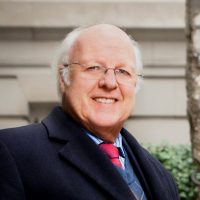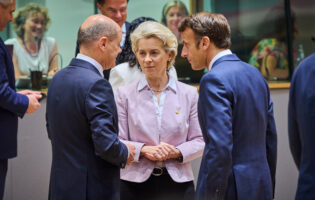Fear Factors

Jackson Janes
President Emeritus of AGI
Jackson Janes is the President Emeritus of the American-German Institute at the Johns Hopkins University in Washington, DC, where he has been affiliated since 1989.
Dr. Janes has been engaged in German-American affairs in numerous capacities over many years. He has studied and taught in German universities in Freiburg, Giessen and Tübingen. He was the Director of the German-American Institute in Tübingen (1977-1980) and then directed the European office of The German Marshall Fund of the United States in Bonn (1980-1985). Before joining AICGS, he served as Director of Program Development at the University Center for International Studies at the University of Pittsburgh (1986-1988). He was also Chair of the German Speaking Areas in Europe Program at the Foreign Service Institute in Washington, DC, from 1999-2000 and is Honorary President of the International Association for the Study of German Politics .
Dr. Janes is a member of the Council on Foreign Relations, the International Institute for Strategic Studies, the Atlantic Council of the United States, and American Purpose. He serves on the advisory boards of the Berlin office of the American Jewish Committee, and the Beirat der Zeitschrift für Außen- und Sicherheitspolitik (ZfAS). He serves on the Selection Committee for the Bundeskanzler Fellowships for the Alexander von Humboldt Foundation.
Dr. Janes has lectured throughout Europe and the United States and has published extensively on issues dealing with Germany, German-American relations, and transatlantic affairs. In addition to regular commentary given to European and American news radio, he has appeared on CBS, CNN, C-SPAN, PBS, CBC, and is a frequent commentator on German television. Dr. Janes is listed in Who’s Who in America and Who’s Who in Education.
In 2005, Dr. Janes was awarded the Officer’s Cross of the Order of Merit of the Federal Republic of Germany, Germany’s highest civilian award.
Education:
Ph.D., International Relations, Claremont Graduate School, Claremont, California
M.A., Divinity School, University of Chicago
B.A., Sociology, Colgate University
Expertise:
Transatlantic relations, German-American relations, domestic German politics, German-EU relations, transatlantic affairs.
__
Plato once wrote, “We can easily forgive a child who is afraid of the dark; the real tragedy of life is when men are afraid of the light.”
Fear is a basic instinct of all mankind. From the time of running from “saber-tooth tigers” to today’s threats of terrorism and violence, fear moves us to protect ourselves from any perceived dangers. If those fears are cloaked in darkness, which scares us, it is easy to exploit that fear among the anxiety-ridden.
Germans are popularly characterized as chronic worriers and risk-adverse, while Americans style themselves as more open to taking chances and optimism. Yet both are susceptible to the contagion of fear. And fear is very contagious on both sides of the Atlantic right now.
The German word Angst has become a widespread symbol for anxiety in many languages. It is found in different forms and expressions. It is interesting to compare the preoccupation Germans have with insurance and cleanliness with the American obsession with sickness and health. Watch TV in both countries and one sees an extraordinary amount of advertisements in the United States focused on all kinds of medicines and drugs. The German version focuses more on getting insured against all kinds of threats as well as varieties of soap and cleaning products. One can get into all kinds of psychology analysis about the sources of these fixations.
Yet today, the many fears we share across the Atlantic are converging on common threats. In Germany, fears are currently stoked by large waves of people seeking asylum—people with real fears about their own mortality and futures and who seek something better in Europe, particularly in an abundant society like Germany. Despite the fact that Germany enjoys one of the strongest economies in the world, fears among many Germans about the future abound, be it personal, local, or national. Anxiety about Germany’s ability to absorb this wave of humanity is rampant. It also takes on dangerous appearances in the form of attacks on those seeking asylum or those who house them. Such incidents are not illustrative of the majority of Germans, but there is clearly Angst spreading about what to do with the perceived threat, which appears to be emerging out of the dark.
In the United States, the same Angst is visible. Here, again, the largest and richest economy in the world appears to many as threatened by those who want a piece of it. The same ugly reactions as in Germany appear stoked by opportunist politicians seeking to seduce voters by playing to their anxieties. The poster boy in America is Donald Trump, but there are all too many acolytes following him in the United States and in Europe.
How does one deal with people being afraid not only of the dark, but also of what it requires to confront it in the light?
Growing Threats and Fears of the Unknown
It is not just the flood of immigrants that is causing contagious fear. Hackers steal documents for nefarious ends; viruses can penetrate both borders and societies; terrorists run rampant in our streets and on our trains; the markets roil, damaging our savings and retirement accounts. The list continues to unnerve. And then there is the loss of trust and confidence in those who are supposed to be leading us through this maze of uncertainty.
In both the German and U.S. political environment today, all these factors result in the fact that fear sells well.
Coming to grips with the current torrent of people seeking survival as refugees from the murderous world they have fled means taking a candid look at the reality of the war and the violence around both the refugees and ourselves. There is no real divide between their world and ours, where people live in the comfort and security of either Europe or the United States. As much as political opportunists want to sell the idea, the two worlds cannot be hermetically sealed off from each other.
This is the light, and it scares people when we recognize how vulnerable we all are to the threats and dangers we share.
The light shows us that 60 million people around the world have been displaced by wars and catastrophic events. The millions fleeing the violence in Syria and Libya are all seeking relief anywhere—in Turkey, Jordan, or European countries—where they want sanctuary. The war-torn regions are breeding camps for more terrorists, and for death, disease, and destruction—and the refugee camps are growing in size and desperation.
Meanwhile, the reaction in Europe to the swelling numbers of migrants among them is testing the capacity to cope at all levels. Germany, in particular, has been taking in increasing numbers of refugees while dealing with the “not in my backyard” reactions in some communities. Rising resentment at local levels against refugees is combining with distrust of the government, which appears to have no long-term plan or capacity to deal with the crisis.
Looking for Answers—and Leadership
Germany is receiving ever-larger numbers of refugees, while neighboring countries such as Hungary and Poland are seeking to build barriers against them and accepting far fewer refugees. Human trafficking is rampant in Bulgaria, and Greece is unable to cope at all with those pouring across its borders. Europe is confronted with a real test of its coherence, capacities, and indeed its sustainability as a union.
Of interest to note is the fact that, while Germany may be looking at well over 800,000 refugees in 2015, the United States has received only 1,500 resettled refugees since 2011. That said, the United States is not only the second largest donor to Syrian humanitarian efforts after Turkey, but it is also spending three times that amount trying to wipe out ISIS.
The forces driving this world-wide flight of millions are overwhelming all of us. We see versions of this vicious circle on the borders of the U.S., as we do on the borders of Europe. While those forces—economic, ideological, religious, ethnic, environmental, or pathological—cannot be completely eliminated, neither can the efforts to seal off those forces be any more successful.
What is needed is a new narrative about the ability of open societies to absorb those knocking on their doors. Looked at in the light, the historical patterns of immigration in the United States and Germany have been a long-term asset. They have in fact been needed. The U.S. has boasted about its capacity to absorb all those coming ashore under the torch of the Statue of Liberty. The actual story of the integration of those immigrants is far less romantic than the narrative. But without them, the United States would not be the success story it is today.
In Germany, the patterns of immigration also go far back with both positive and horrific chapters involved. But more recently, Germany saw over three million people arrive from Eastern Europe and Russia toward the end of the Cold War, along with thousands of asylum seekers fleeing the Balkan wars in the 1990s. The Federal Republic managed to get through those challenges, as they will the current one.
Offering Opportunity: A German-American Imperative
But getting through means cutting through the rhetoric to the reality of the crisis, setting it in its full light, and not being afraid to confront the challenges. The Federal Republic is not threatened by refugees. It is threatened by its sluggish and ad hoc responses to the current wave of people seeking safety. It is threatened by an inadequate capacity of a both a national strategy as well as a common European response to deal with both the refugees at Europe’s borders and their reasons for fleeing their own homes. Germany has the capacity to deal with those who deserve asylum. It is simply not using it effectively. The EU has the potential of using a common strategy to sort out how to deal with asylum seekers and immigrants. Right now, it is failing at both.
This is not just a European failure. There is no real threat from refugees to the American Republic. And the millions of illegal aliens currently in the U.S. are not shaking its foundations, despite the thunderous pontificating of politicians stoking the fear that too many Americans continue to hold about our country’s changing demographics.
The facts show that the presence of illegal or undocumented immigrants generates more long-term benefits than disadvantages in economic terms. Where there are negative trade-offs, such as undereducated workers losing jobs or increasing pressure on local infrastructure, solutions are available if we focus more on their implementation and less on highly volatile hyperbole around the presidential campaigns.
Neither Germany nor the United States can prevent people from wanting to seek refuge from danger or improve their life chances. Nor should they. Offering opportunity is a basic narrative of both countries. In the light of day, the need to craft methods and means to facilitate and manage that flow is difficult, demanding, and needed. At the same time, offering resources to all those who choose to stay and build a life where they are is just as important. Both are necessary. But these efforts are not going to be successful if we are afraid of both the dark and the light.








